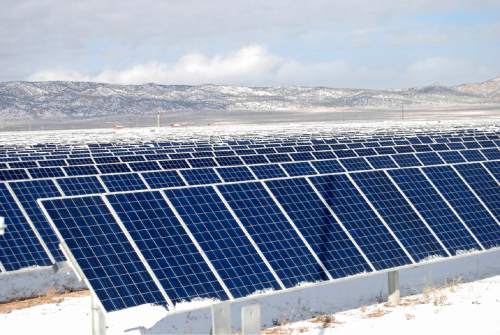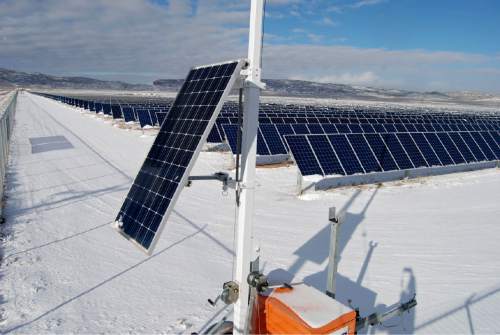This is an archived article that was published on sltrib.com in 2015, and information in the article may be outdated. It is provided only for personal research purposes and may not be reprinted.
Utah unveiled its first large utility-scale solar farm Thursday with the dedication of the Utah Red Hills Renewable Park, part of a solar-energy construction boom expected to increase the state's generating capacity by 915 megawatts in the coming months.
The Norwegian firm Scatec Solar built and operates the project's 340,700 photovoltaic panels on 632 private acres west of Parowan.
The $188 million project is capable of generating 210 million kilowatt hours a year, enough to power 18,500 homes, but it will soon be eclipsed by larger solar farms slated for Utah's sunbathed southwest corner.
"The fact that we were able to build this 104 [megawatt DC] plant within 12 months is the proof of our company's capability to deploy solar power rapidly. The Utah plant also underlines the importance of delivering results and choosing partners whose core values match our own — in this case, Swinerton, Google and Prudential Capital Group," said Raymond Carlsen, Scatec CEO, referring to the project's finance and construction partners.
Translated into alternating current, or AC, the new plant represents 80 megawatts of generating capacity.
Under a 20-year agreement, Rocky Mountain Power will purchase this power. Utah's largest utility will also purchase power from about 20 other projects under development in Iron, Beaver and Millard counties, according to Jeff Barrett of the Utah Office of Energy Development.
"Pilings are being driven and hundreds of thousands of panels are being installed as this one is coming online," Barrett said. "We go from a state that has lagged on a proportional basis in the area of emission-free [power] generation. Now we are becoming a leader and it's just on the back of a couple of years of development. I wouldn't be surprised if we see a pause coming up."
With these new projects online, renewables will account for about 10 percent of RMP's generating capacity.
SunEdison, the world's largest renewable energy firm, is building most of the upcoming projects, which are typically arrays with capacities of 20 megawatts or less. Its 3.8-megawatt South Milford plant came online back in May and has since been acquired by TerraForm Power.
Red Hills will be dwarfed by SunEdison's largest plants: the 265-megawatt Three Cedars and 420-megawatt Four Brothers projects under development in Iron County. Three Cedars is expected to add 250 construction jobs and generate $17 million in property and income tax revenue over 20 years. None of the new projects is being built on public land, though the Bureau of Land Management has designated three "solar energy zones" in this area where federal permitting would be streamlined.
The Red Hills project includes a visitor center named for the late Dennis Stowell, a state senator who represented Iron County.
Thursday's dedication was attended by Stowell's successor, Evan Vickers, and other elected leaders, along with representatives of Gov. Gary Herbert's administration.
Parowan welcomes projects, according to City Manager Shayne Scott, who attended Thursday's event. Parowan operates its own power company, which relies on hydro for one-quarter of its electrical load.
"We look out to the future and see renewables all around us. Having this out there will help us get the word out why renewables are important," Scott said. "We have a little gold rush going on in our valley. It was quite a boon just for the construction."
He added that Parowan's 6,000-foot elevation makes this valley attractive for solar development.
"The higher elevation is better for solar panels. They are more efficient when it's cooler," he said. Also enhancing its efficiency is its single-axis tracking system. Instead of a fixed mount with panels facing due south, Red Hills' panels are mounted on bars that align north-south. The moving panels face east in the morning and rotate with the movement of the sun.
Brian Maffly covers public lands for Salt Lake Tribune. He can be reached at bmaffly@sltrib.com or 801-257-8713. Twitter: @brianmaffly





